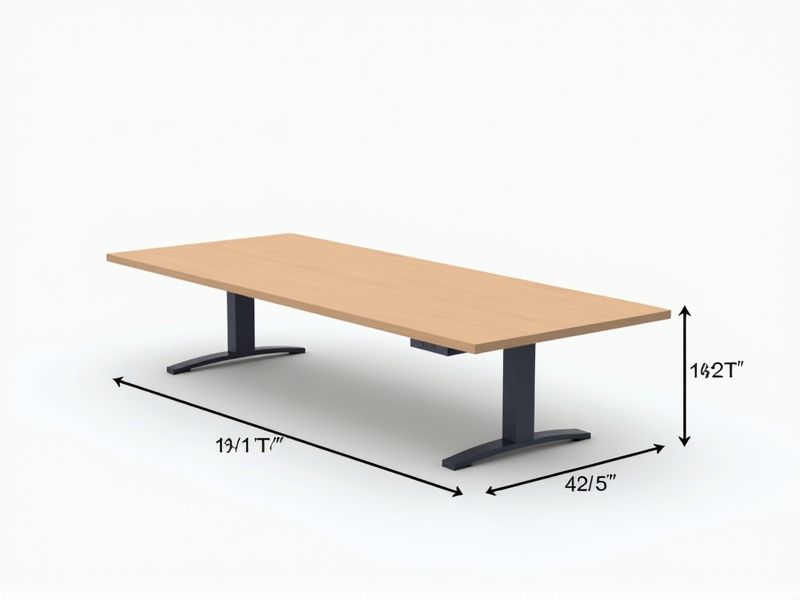
When selecting a conference table, it's important to consider standard dimensions to ensure comfort and functionality. Most conference tables are 30 inches tall, which matches the standard height for most office chairs. Typical widths range from 36 to 48 inches, allowing adequate space for seating and movement around the table. For length, a good rule of thumb is to provide 24 to 30 inches of table space per person, so a 96-inch (8-foot) table comfortably seats eight people.
Length Options
Conference tables typically range in length from 6 to 20 feet, catering to various group sizes and meeting types. A 6 to 8-foot table is ideal for small meetings of up to eight participants, providing a comfortable space for discussion. For larger groups, consider tables measuring between 10 to 12 feet, which can accommodate up to 12 attendees with ease. If your team exceeds 12 members, opting for a 16 to 20-foot table ensures everyone has a seat while maintaining an organized atmosphere.
Width Options
Conference tables typically offer a range of width options, with standard measurements commonly spanning from 36 inches to 72 inches. A width of 48 inches effectively accommodates up to six participants, promoting a comfortable workspace. For larger groups, tables exceeding 60 inches can facilitate collaboration among eight or more attendees while maintaining personal space. When selecting a width, consider your room dimensions and the need for added equipment, like projectors or screen setups, to ensure optimal functionality and comfort.
Height Considerations
When selecting a conference table, consider the standard height range of 28 to 30 inches for optimal comfort and accessibility. This height allows users to engage easily without straining their arms or backs, enhancing collaboration during meetings. If your team includes individuals who use wheelchairs, ensure the table design accommodates a height of at least 30 inches for proper clearance. Ergonomics plays a vital role; thus, the right height not only boosts productivity but also leaves a lasting impression on clients and partners.
Seating Capacity
When selecting a conference table, seating capacity is a crucial factor to consider. For a small team, a table that accommodates 6 to 8 seats is ideal, providing enough space for comfortable discussions without crowding. Larger conferences typically require tables that can seat 10 to 14 individuals, allowing for productive meetings while ensuring everyone can participate. Understanding your specific needs helps in choosing the right size to enhance collaboration and maintain a professional atmosphere.
Legroom Space
When selecting a conference table, prioritize legroom, ensuring at least 24 inches of space per seated participant for optimal comfort. Standard designs typically offer a height of 28 to 30 inches, accommodating various chair styles without compromising accessibility. Consider tables ranging from 6 to 12 feet in length, depending on the number of attendees; a rectangular table provides versatile seating arrangements. Adequate legroom not only enhances comfort but also fosters productivity during meetings, allowing for better engagement and collaboration.
Material Choices
When selecting a conference table, prioritize materials that enhance durability and aesthetics. Solid wood tables, such as oak or walnut, offer longevity and a classic appeal, while glass tops provide a modern and sleek look, allowing for easy maintenance. Consider plywood for a more cost-effective option without compromising on quality, as it combines sturdiness with versatility. Going for a table with a surface finish that resists scratches and stains can significantly extend its lifespan, ensuring it remains an asset for your meetings for years to come.
Shape Variations
Conference tables come in a variety of shapes, each designed to enhance collaboration and communication within a meeting space. The most common shapes include rectangular, round, oval, and U-shaped, with rectangular tables often accommodating larger groups of up to 20 participants. Round tables, ideal for smaller gatherings, promote inclusivity and direct eye contact between participants. Understanding the unique benefits of each shape can significantly improve your meeting dynamics and overall productivity.
Ergonomic Design
A conference table designed with ergonomic principles enhances comfort for all participants, fostering better collaboration and communication. The optimal height for such tables typically ranges from 28 to 30 inches, accommodating varied user needs while ensuring ergonomic seating arrangements. Incorporating features like rounded edges and adjustable components can further promote user well-being, reducing strain during extended meetings. Selecting materials with a soft finish also minimizes discomfort, contributing to a more productive conference environment.
Technology Integration
A standard conference table designed for technology integration typically measures around 6 to 10 feet in length, accommodating 6 to 12 participants. It often features built-in power outlets, USB ports, and HDMI connections, enabling seamless connectivity for laptops and presentation devices. Many models include integrated screens for video conferencing, enhancing collaboration and communication among remote team members. Investing in a technology-integrated conference table can significantly boost productivity and streamline meetings in today's digital work environment.
Ada Compliance Considerations
Conference tables designed for ADA compliance must accommodate individuals with disabilities, ensuring easy accessibility and comfort. A standard table height is typically around 28 to 30 inches, with a clear knee space of at least 27 inches in height to accommodate wheelchair users. It's essential to provide a surface width of at least 30 inches, allowing for adequate space for mobility devices. Incorporating rounded edges and a stable design will enhance safety, making your conference environment inclusive for all participants.
